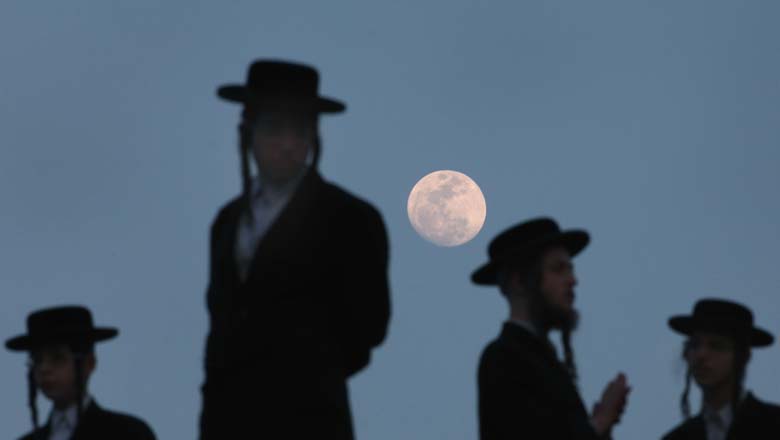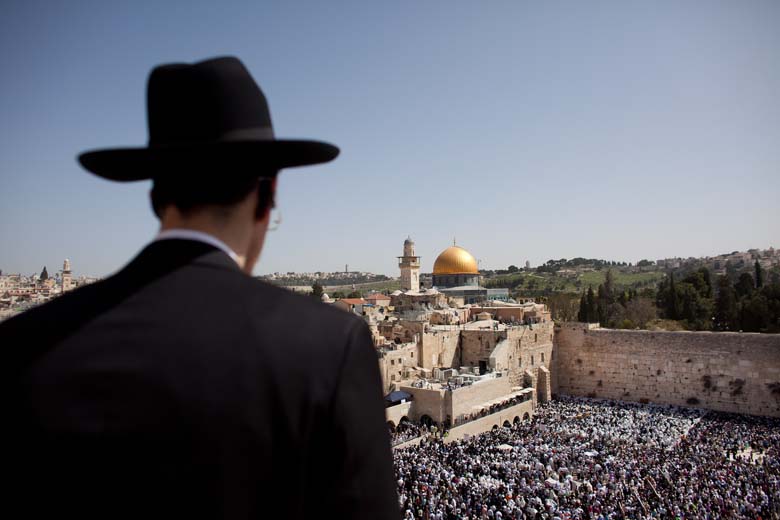
The moon rises behind ultra-Orthodox Jews on the outskirts of Jerusalem during Passover. The week-long festival which begins night and commemorates the hasty flight of the Jews from ancient Egypt as described in the biblical book of Exodus. (David Silverman/Getty Images)
Happy Passover 2017! Also known as Pesach, today is the first day of the week-long Jewish festival that commemorates the emancipation of the Israelites by God from slavery in ancient Egypt. The story of the Exodus is described in the Hebrew Bible, especially in the Book of Exodus. In the Book of Exodus, Moses leads the Israelites across the Red Sea and through the deserts to Mount Sinai, where God promises them the land of Canaan as thanks for their faithfulness.
Canaan today includes Lebanon, Israel, Palestine, northwestern Jordan, and some western areas of Syria, according to Canaanites by Jonathan N. Tubb.
Learn more about the history and origins of Passover here!
1. It May Have Pagan Roots

A picture taken on March 14, 2014 shows carvings on a wall in the courtyard of the sanctury of Baal in the ancient oasis city of Palmyra, 135 miles northeast of Damascus. From the 1st to the 2nd century, the art and architecture of Palmyra, standing at the crossroads of several civilizations, married Graeco-Roman techniques with local traditions and Persian influences. (JOSEPH EID/AFP/Getty Images)
The events described in the Book of Exodus are believed to have transpired around 1,300 BCE, according to the Seder Olam Rabbah. During this time, there were many religions in the Middle East, and ancient Jews practiced not monotheism, but henotheism. According to Dictionary.com, henotheism is “the worship of a particular god, as by a family or tribe, without disbelieving in the existence of others.”
A Bible quote commonly referenced as evidence for Israelite henotheism is Genesis 31:53, which reads, “May the God of Abraham and the God of Nahor, the God of their father, judge between us. So Jacob took an oath in the name of the Fear of his father Isaac.”
Because of henotheism and the transient nature of the early people that would become modern day Jews, some believe that they picked up the customs and religious traditions of the ancient people that they met and conquered. The idea that Passover was a custom not from Egypt, but from Canaan itself, is also found in the Bible. God tells Moses and Aaron to commemorate Passover with the blood of the lamb and to forego leaven bread. It is not written in the Bible that Moses passes along the message about foregoing leaven bread to his people. Because of this, some believe that the Passover used to be two separate holidays that were combined when the Israelites conquered the Canaanites.
The Israelites celebrated the slaughtering of the lamb, while the Canaanites celebrated the festival of matza, or unleavened bread. Haaretz writes:
Nearly all ancient Canaanites – Hebrews included – were farmers, and Passover takes place just at the most critical time of the year, at the end of the growing season, just before the harvest.
This was a time of great anxiety, since the rains that made their grains grow during the winter were no longer welcome. One particularly nasty storm could decimate wheat and barley fields, knocking down the ripe plants and rotting the grains, and the people would starve.
Somehow the ancients had to stop the rains, and this could be the original function of Passover.
The rain would be stopped by the rain god. The rain god in question is also mentioned in the Bible multiple times: Baal.
2. The Story of Passover

Animals suffering pestilence during the series of ten plagues in Egypt. Original Artwork: Engraving after illustration by Gustave Dore (of 1865 – 1866). (Rischgitz/Getty Images)
Passover celebrates the story of Moses and the exodus of Jews. In the story, the pharaoh decrees that the first-born sons of all the Israelites (serving as slaves in Egypt) are to be killed. The pharaoh is fearful that the boys will soon outnumber the native Egyptians and fight his rule.
In an effort to protect baby Moses from Pharaoh’s infanticide, his mother, Amram, sends him down the river Nile in a basket. Somewhere down the river he is retrieved by the pharaoh’s daughter, Bithiah, and raised as a member of the Egyptian royal family. After finding out his true identity, Moses fights for the freedom of the Jewish people and brings ten plagues on the land of Egypt until the pharaoh agrees to set his people free.
The last of these plagues is where Passover draws its roots, where the Angel of Death kills the firstborn of every Egyptian.
3. Passover Begins at Sundown

Thousands of Israelis attend the Annual Cohanim prayer, or Priest’s blessing, for the Pesach (Passover) holiday, on April 9, 2012 at the Western Wall in Jerusalem’s old city. (Uriel Sinai/Getty Images)
This year Passover begins at sundown on Monday, April 10, and runs through Tuesday, April 18.
Jewish holidays begin at sundown because, according to the Bible, days begin at sundown. This is based on the story of creation from Genesis, where at the end of each day it reads, “And there was evening, and there was morning” after every day. Because the Torah defines a day as beginning with the evening, so do the Jewish people.
The observation of a new day beginning with the moon is also reflected in the Hebrew calendar, which is a lunar calendar. This is also the reason why the dates of Jewish holidays change every year. The lunar calendar reflects the cycles of the moon, and when it is compared to or tried to fit into a 12-cycle solar calendar (that most of the Western world uses), there are slightly more than twelve lunations (or moon phases) in a solar year.
4. The Traditions of Passover Come From Its Story

People of various faiths and nationalities attend an interfaith Passover celebration at the home of Sharona Shapiro April 5th, 2004 in West Bloomfield, Michigan. Shapiro, the Michigan area director of the American Jewish Committee, held the function in an effort to reach out to non-Jewish people, and invited guests who were Muslim, Polish, Hindu, Chaldean, African American, and Nigerian. (Bill Pugliano/Getty Images)
Most of the rules and traditions come from the story of Passover above. This also applies to the dietary restrictions followed by observant Jews during the length of Passover. According to the story, because the Jewish people left Egypt in a hurry, there was no time for their bread to rise in their ovens. Needing something to eat, the Jews let the dough bake on their backs in the hot sun, preventing the bread from rising but creating flat unleavened bread, which we know now as matzah. Because of this story, it is traditional to eat nothing with leavened bread in it during the 8 days of Passover.
Two things that you’ll see at any Passover seder are the Haggadah and the Seder plate. The Haggadah is the specific prayer book that leads a group through the rituals, prayers, stories, and songs essential for the observance of Passover.
A Seder plate contains the essential symbolic ingredients of Passover. The dish holds the shank bone, egg, bitter herbs, apple paste, and a vegetable. The bone represents the lamb sacrificed on the night before the exodus from Egypt, the egg represents the traditional offering left at the temple, the bitter herbs are the bitterness of slavery in Egypt, the paste represents the mortar used to build the structures of Egypt, the vegetable represents the labor of the enslaved. Salt water is also necessary to represent the tears of the Israelites.
5. Jesus’ Last Supper May Have Been a Seder

Frederik Mayet (c) as Jesus Christ and ensemble members perform the scene of the Last Supper on stage during the Oberammergau passion play 2010 final dress rehearsal on May 10, 2010 in Oberammergau, Germany. (Johannes Simon/Getty Images)
Palm Sunday, which leads to Easter, sometimes coincides with Passover. In three out of the four canonical gospels, (Matthew, Mark and Luke), it is written that Jesus’ Last Supper occurred “on the first day of the Festival of Unleavened Bread, when it was customary to sacrifice the Passover lamb,” according to Mark 14:12.
However, according to Biblical Archaeology, we may be projecting our zeitgeist onto the past, especially because the gospels were written long after Jesus died. They write, “if we cannot know how Jews celebrated Passover at the time of Jesus, then we have to plead ignorance, and we would therefore be unable to answer our question.”
Whatever the answer is, it’s a time of major holidays for many populations around the world.
Easter, the Christian holiday that celebrates the resurrection of Jesus, is on April 16.